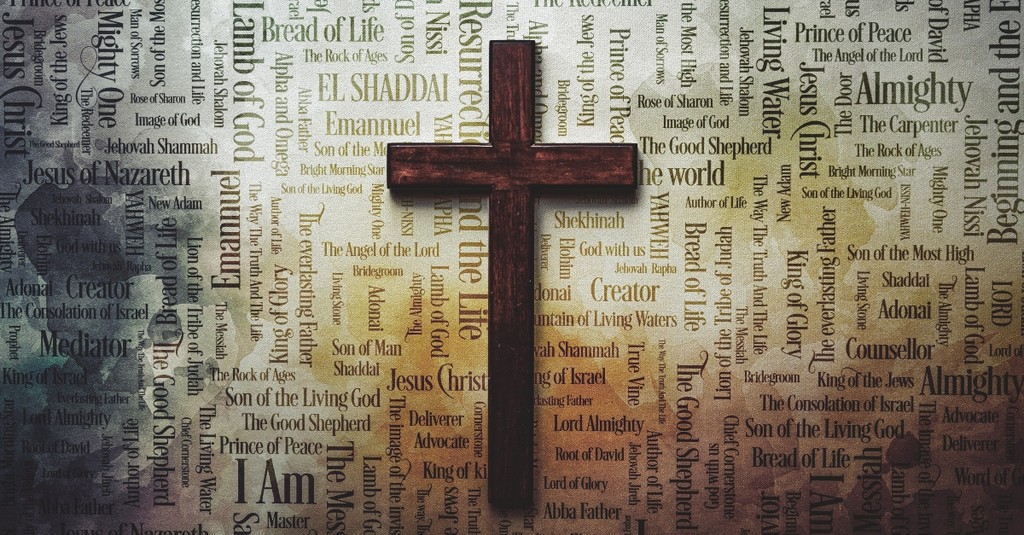
When Moses encounters the burning bush in the wilderness, he draws near and comes into contact with God. The conversation between the two begins, and Moses asks an important question, “What is your name?”
Moses had been raised in Egypt, and the gods of Egypt each had a name. In speaking with the divine, a name can tell us a great deal. Which god was Moses speaking to? God answers with a simple statement. “I am.” Not a god of the sky or the seas. But the one who actually exists. The God above all.
The Israelites used this name for God, in Hebrew, Yahweh.
A few thousand years later, the Son of God appears on earth, fully human and fully divine. Jesus also identifies himself several times, telling us who he is. The following “I am” statements from the Gospels give us a good start to answer the question, “Who is Jesus?”
Photo Credit: ©iStock/Getty Images Plus/Javier_Art_Photography

1. Bread of Life
In stating, “I am the Bread of Life,” Jesus not only satisfies physical hunger but also addresses the deeper hunger of the soul for spiritual nourishment and eternal life.
In the Old Testament, we find foreshadowing of Jesus as the bread of life in the story of the manna provided to the Israelites in the wilderness. Exodus 16 recounts how God provided bread from heaven to sustain his people during their journey. This miraculous provision prefigures Jesus’ role as the ultimate source of spiritual sustenance and nourishment.
Moreover, the concept of bread carries rich symbolism throughout the Old Testament, particularly in the context of offerings and sacrifices. For instance, the bread of the Presence placed in the Tabernacle symbolized God’s continual presence and provision for His people (Exodus 25:30).
In the New Testament, Jesus’ assertion of being the bread of life is recorded in John 6:35, where He declares,
“I am the bread of life; whoever comes to me shall not hunger, and whoever believes in me shall never thirst.”
Here, Jesus offers Himself as the solution to our spiritual hunger and thirst, inviting us to partake in him. In the same discourse, Jesus elaborates on this metaphor, stating that his flesh is true food and his blood is true drink, alluding to the sacrificial nature of His impending death on the cross and the establishment of the new covenant (John 6:51-58).
Photo Credit: ©iStock/Getty Images Plus/Mizina

2. Light of the World
Jesus’ declaration, “I am the light of the world,” signifies His identity as the source of spiritual illumination and guidance. We find this theme in both the Old and New Testament: God dispelling darkness and revealing truth to us.
In the Old Testament, light is frequently used metaphorically to symbolize God’s presence, guidance, and salvation. Psalm 27:1 proclaims, “The Lord is my light and my salvation—whom shall I fear?” Here, God’s light represents deliverance from fear and darkness. Similarly, Isaiah 9:2 prophesies about the coming Messiah, declaring, “The people walking in darkness have seen a great light; on those living in the land of deep darkness, a light has dawned.” This anticipates the arrival of Jesus as the embodiment of divine illumination and salvation.
In John 8:12, Jesus declares,
“I am the light of the world. Whoever follows me will never walk in darkness but will have the light of life.”
Here, we see Christ’s light gives us sight and leads us in the ways of life, not death.
Moreover, Jesus’ ministry and teachings demonstrate his function as the light of the world. His miracles, such as restoring sight to the blind and casting out demons, illustrate his power to overcome darkness and bring healing and wholeness to those in need (John 9:1-7, Mark 1:32-34).
Photo Credit: © Pixabay/Eberhard Grossgasteiger

3. Door to the Sheep
His saying, “I am the door to the sheep," conveys His role as the exclusive means of access to God and His kingdom. This statement carries rich symbolism, drawing upon Old and New Testament imagery to illustrate Jesus’ unique position as the gateway to salvation and eternal life.
In the Old Testament, references to doors often symbolize protection, security, and provision. Psalm 118:20 tells us, “This is the gate of the Lord through which the righteous may enter,” symbolizing the way to God’s presence and blessings.
Jesus asserts being the door to the sheep in John 10:7-9,
“Truly, truly, I say to you, I am the door of the sheep. All who came before me are thieves and robbers, but the sheep did not listen to them. I am the door. If anyone enters by me, he will be saved and will go in and out and find pasture.”
Jesus reveals his exclusivity as the only means by which we can enter into a relationship with God and experience salvation. We are identified as the sheep, but not all sheep belong to God. We become his sheep through repentance and faith. There are other shepherds and other pastures, but those leaders will abuse their sheep. We desire a good shepherd, and there is only one.

4. The Good Shepherd
When Jesus states, “I am the good shepherd,” he encapsulates his role as the compassionate and self-sacrificial leader of His followers. This statement draws upon rich biblical imagery from both the Old and New Testaments to illustrate Jesus’ care, protection, and willingness to lay down His life for His sheep.
In the Old Testament, the metaphor of the shepherd is frequently used to depict God’s relationship with his people and the qualities of a righteous leader. Psalm 23 poetically describes God as the shepherd who guides, protects, and provides for His flock. Additionally, Ezekiel 34:11-16 portrays God as the Shepherd who seeks out His scattered sheep, rescues them from harm, and ensures their flourishing. In the New Testament, Jesus proclaims being the good shepherd in John 10:11:
“I am the good shepherd. The good shepherd lays down his life for the sheep.”
Jesus shows his sacrificial love and commitment to his followers, contrasting his selfless devotion with the actions of hired hands who abandon the sheep in times of danger (John 10:12-13). Furthermore, Jesus’ role as the good shepherd is intimately connected to his mission of redemption and salvation. In John 10:15, Jesus teaches,
“Just as the Father knows me and I know the Father—and I lay down my life for the sheep.”
This affirmation underscores the unity between Jesus and the Father and highlights his willingness to offer himself as a ransom for humanity’s sins (Mark 10:45).
Photo Credit: KristiLinton

5. Ressurection and the Life
Jesus utters the words, “I am the resurrection and the life,” and encapsulates his authority over death and his promise of eternal life for believers. Both the Old and New Testaments underscore Jesus’ role as the source of spiritual and physical resurrection.
In the Old Testament, the concept of resurrection is hinted at in passages such as Job 19:25-27, where Job expresses his faith in God’s eventual vindication and restoration, even in the face of death. Additionally, Ezekiel 37:1-14 records the vision of the valley of dry bones, symbolizing Israel's restoration and revival under God’s power.
Jesus comes to the grave of Lazarus, his friend, and in conversation with Martha, he says to her,
“I am the resurrection and the life. The one who believes in me will live, even though they die, and whoever lives by believing in me will never die.”
Christ proceeds to raise Lazarus from the dead, giving tangible evidence that the person of the Son of God is the promise of later resurrection from the dead. Jesus later reinforces this proclamation by his own resurrection of the dead. In 1 Corinthians 15:20-22, the Apostle Paul affirms Jesus’ resurrection as the first fruits of those who have fallen asleep, signaling the defeat of death and the assurance of resurrection for us who believe.
Photo Credit: ©GettyImages/KatarzynaBialasiewicz

6. Alpha and Omega
Jesus personalizes his eternal and sovereign nature over all Creation by declaring, “I am the Alpha and Omega.”
In the Old Testament, the titles Alpha and Omega find their roots in God’s self-declaration of being the “first and the last” in Isaiah 44:6:
“I am the first, and I am the last; besides me, there is no god.”
This statement emphasizes God’s eternal existence and unmatched rule and authority. Similarly, in Isaiah 41:4, God reiterates his unique position as the one who existed from the beginning and will continue to exist into eternity.
Jesus appropriates these titles to Himself in Revelation 22:13, where he declares,
“I am the Alpha and the Omega, the first and the last, the beginning and the end.”
This assertion emphasizes Jesus’ identification with the divine, affirming his role in creation, redemption, and the fulfillment of God’s ultimate purposes for humanity. Christ’s declaration as the Alpha and Omega echoes the prophetic anticipation of his coming and his ultimate victory over sin and death. In Revelation 1:8, the Lord God declares,
“I am the Alpha and the Omega, who is and who was and who is to come, the Almighty.”
Just as Christ was there at Creation as the Word, he who is God and through whom God made all things, he also carries the role of bringing about the new heavens and the new earth in the culmination of all things.
Photo Credit: ©GettyImages/Romolo Tavani

7. The True Vine
Jesus, using the metaphor of the “true vine,” draws upon rich biblical imagery to illustrate Jesus’ role as the source of abundant life and fruitfulness for his disciples.
In the Old Testament, the imagery of the vineyard is frequently used to symbolize Israel as God’s chosen people and their relationship with Him. For instance, Isaiah 5:7 portrays Israel as the vineyard of the Lord, and Psalm 80:8-9 describes God as the one who brought a vine out of Egypt planted it, and cared for it. However, Israel's unfaithfulness led to the vineyard’s degeneration and fruitlessness.
Jesus adopts this imagery for himself in John 15:1, declaring,
“I am the true vine, and my Father is the gardener.”
Christ identifies himself as the authentic source of spiritual life and vitality, contrasting with the failure of Israel to fulfill its role as God’s vine. Through this metaphor, Jesus emphasizes how we must abide in him to bear fruit and experience true discipleship.
As the true vine, Jesus highlights his role as the mediator between God and humanity. In John 15:5, Jesus states,
“I am the vine; you are the branches. If you remain in me and I in you, you will bear much fruit; apart from me, you can do nothing.”
Our connection to the Father happens through being intimately attached to the Son, giving us access to the Holy Spirit for life and the power to walk with the Father in humility.
In each case, Jesus speaks of himself in ways and terms to help us begin to understand the abundant roles he has in our salvation. These ideas were also connected to themes across redemptive history and the revelation of God in the Old Testament. Jesus affirms the revelation which came before while expanding it to show how he brings completion to the redemptive story of God. Many of these names promise intimacy and protection, deliverance, and hope for all who will trust in him. He’s worthy of our trust.
Photo Credit: ©iStock/Getty Images Plus/Feverpitched

Originally published Thursday, 29 February 2024.
